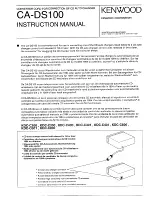
40-8
Cisco Security Appliance Command Line Configuration Guide
OL-12172-03
Chapter 40 Managing System Access
Configuring AAA for System Administrators
This command also enables support of administrative user privilege levels from RADIUS, which can be
used in conjunction with local command privilege levels for command authorization. See the
“Configuring Local Command Authorization” section on page 40-10
for more information.
Step 2
To configure the user for management authorization, see the following requirements for each AAA
server type or local user:
•
RADIUS or LDAP (mapped) users—Configure the Service-Type attribute for one of the following
values. (To map LDAP attributes, see the
“LDAP Attribute Mapping” section on page 13-14
.)
–
admin—Allows full access to any services specified by the
aaa authentication console
commands.
–
nas-prompt—Allows access to the CLI when you configure the
aaa authentication
{
telnet |
ssh} console
command, but denies ASDM configuration access if you configure the
aaa
authentication http console
command. ASDM monitoring access is allowed. If you configure
enable
authentication with the
aaa authentication enable console
command, the user cannot
access privileged EXEC mode using the
enable
command.
–
remote-access—Denies management access. The user cannot use any services specified by the
aaa authentication console
commands (excluding the
serial
keyword; serial access is
allowed).
•
users—Authorization is requested with the “service=shell” and the server responds with
PASS or FAIL.
–
PASS, privilege level 1—Allows full access to any services specified by the
aaa authentication
console
commands.
–
PASS, privilege level 2 and higher—Allows access to the CLI when you configure the
aaa
authentication
{
telnet | ssh} console
command, but denies ASDM configuration access if you
configure the
aaa authentication http console
command. ASDM monitoring access is allowed.
If you configure
enable
authentication with the
aaa authentication enable console
command,
the user cannot access privileged EXEC mode using the
enable
command.
–
FAIL—Denies management access. The user cannot use any services specified by the
aaa
authentication console
commands (excluding the
serial
keyword; serial access is allowed).
•
Local users—Set the
service-type
command. See the
“Configuring the Local Database” section on
page 13-7
. By default, the
service-type
is
admin
, which allows full access to any services specified
by the
aaa authentication console
commands.
Configuring Command Authorization
If you want to control the access to commands, the security appliance lets you configure command
authorization, where you can determine which commands that are available to a user. By default when
you log in, you can access user EXEC mode, which offers only minimal commands. When you enter the
enable
command (or the
login
command when you use the local database), you can access privileged
EXEC mode and advanced commands, including configuration commands.
This section includes the following topics:
•
Command Authorization Overview, page 40-9
•
Configuring Local Command Authorization, page 40-10
•
Configuring Command Authorization, page 40-13
Содержание 500 Series
Страница 38: ...Contents xxxviii Cisco Security Appliance Command Line Configuration Guide OL 12172 03 ...
Страница 45: ...P A R T 1 Getting Started and General Information ...
Страница 46: ......
Страница 277: ...P A R T 2 Configuring the Firewall ...
Страница 278: ......
Страница 354: ...17 38 Cisco Security Appliance Command Line Configuration Guide OL 12172 03 Chapter 17 Configuring NAT NAT Examples ...
Страница 561: ...P A R T 3 Configuring VPN ...
Страница 562: ......
Страница 891: ...P A R T 4 System Administration ...
Страница 892: ......
Страница 975: ...P A R T 5 Reference ...
Страница 976: ......
















































